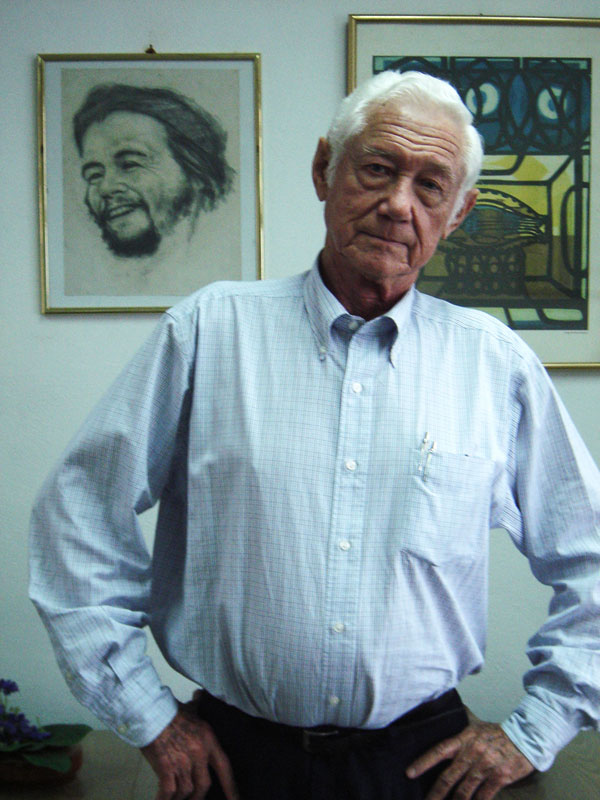
Enrique Oltuski Osacki
18 October 1930-16 December 2012
Enrique Oltuski made an indelible contribution to the revolutionary struggle in 1950s Cuba, to the process of socialist transition and as member of government until his death, aged 83, on 16 December 2012. Oltuski led the urban wing of the Movement of the 26th July (M26J) in central Cuba in the final year before the Revolution toppled the Batista dictatorship in January 1959. The English publication of his memoirs, Vida Clandestina, was politically important in undermining the lie that Cuba’s urban population was not active in the revolutionary struggle.
Born in Cuba in 1930 to a family of Polish Jewish immigrants, his family lived in Santa Clara in central Cuba, where his parents’ business prospered. Oltuski wanted for nothing, bothered only by the grinding daily poverty around him: ‘I saw barefoot children my own age begging, elderly people dressed in rags. At night women with children in their arms slept in the doorways of public buildings and in parks…we concluded that this had to be changed.’*
Oltuski went to the US where he studied architectural engineering at the University of Miami before working for a couple of years as an architect in Florida, with the intention of setting up his own business in Cuba. He began to read Marx and to learn about the Bolshevik Revolution. Returning to the island on holiday following Batista’s coup in 1952, he was drawn into the revolutionary struggle against the US-backed dictatorship, joining first the Nationalist Revolutionary Movement and, when that was disbanded, the M26J in Havana. In 1955 he moved back to Cuba permanently to take an active role in the struggle. He was employed in the Technical Department at Shell Oil, joining the exclusive Rotary Club and cultivating an image as a promising young entrepreneur as a cover for his revolutionary activities. This activism was necessarily secret because of the brutal repression by the regime.
When Shell Oil sent him to Santa Clara as the technical head of Las Villas, he became responsible for leading the M26J in the province (from January 1958), under the nom de guerre ‘Sierra’. ‘It was an honour, but also your life was in greater danger than ever before,’ he explained.
‘We collected money to buy guns for the armed struggle in the mountains, published the underground press and distributed it to the population; we organised the student and workers movements and we carried out sabotage against the government. We blew up electrical installations, set fire to sugar cane fields that belonged to members of the Batista regime.
We ambushed and killed the Batista police who tortured and murdered our comrades. This was the struggle in the cities and we worked to convince the people through clandestine propaganda that the government were exploiters and that we had to create a government which represented the true interests of the people, that we had to have agrarian reform, educate people, build hospitals to care for the health of the population.’
Oltuski provided a vital link between Che Guevara, who arrived with the Rebel Army column in the Escambray Mountains in central Cuba in October 1958, and the urban movement. The battle for control of Santa Clara, headed by Guevara, was a decisive victory for the revolutionary forces against the Batista regime. Despite some initial disagreements about strategy, Oltuski went on to collaborate closely with Guevara.
Oltuski was one of only three representatives of the M26J to enter the Council of Ministers in the first government in January 1959 as Minister of Communications. In 1960, he joined the Department of Industrialisation to work with Guevara who had been given responsibility for the development and socialisation of Cuban industry. As Director of Organisation, Oltuski helped create the operational shell of the Budgetary Finance System (BFS), Guevara’s innovative system of economic management for the transition to socialism in the concrete conditions in 1960s Cuba.** They studied existing laws, created new laws, formulated the enterprises’ plan of production, decided how to control the factories within different sectors and determined relations between those sectors and the ministry, and between the ministry and the central government. Oltuski recalled: ‘This work took us months. The ideas were taken to the Management Council for debate and approved or adjusted.’ Through the BFS, Guevara attempted to take the structural and managerial efficiencies of the capitalist monopolies and apply them to a socialist framework. Oltuski was key in explaining how those management techniques and organisational structures worked. ‘I had mastered all of these things in my studies in the United States and I applied them in the structure of the enterprises we were creating…We discussed it, Che and I. We spoke about the common structures of both systems – capitalism and socialism.’
In 1961, when the new Ministry of Industries was opened, Oltuski transferred to work under Guevara’s instructions on the Council for Economic Planning (today the Ministry of the Economy and Planning) as vice minister. Later, and until his death, he worked as vice minister in the Ministry of Fishing.
In 2005 in Havana, Oltuski told me: ‘I was lucky to be part of the revolutionary government and to work to develop the ideas that we had since we were young about changing Cuba and building a society in the interests of all the people and not an exploiting minority. We still haven’t finished, there are many things to improve.’ This effort continues, he said, despite the blockade and threat of invasion, ‘because we are in the process of building a society which many people in the world understand should exist in their own counties.’
Helen Yaffe
* All quotes are from interviews by Helen Yaffe with Enrique Oltuski in Havana, 12 January 2005 and 15 February 2006.
** For details see Helen Yaffe, Che Guevara: the economics of revolution, Palgrave 2009.
Fight Racism! Fight Imperialism! 231 February-March 2013




